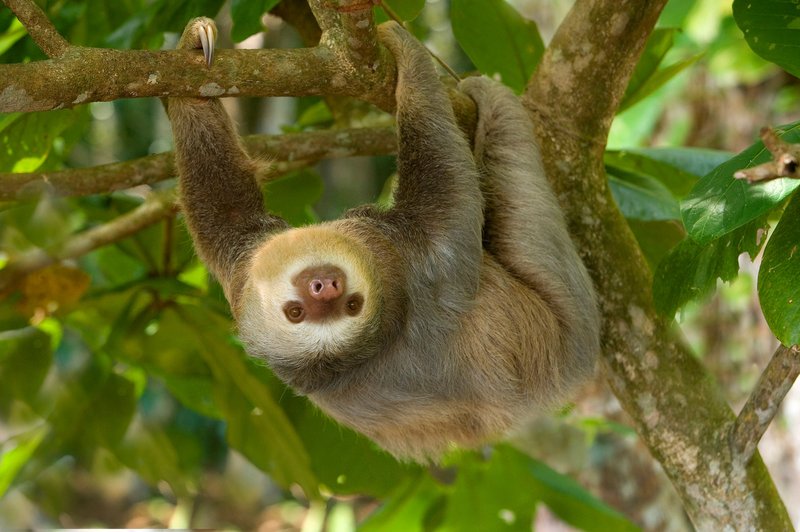
Two-toed sloths are fascinating animals native to Central and South America. Their quirky habits and slow pace make them the stars of the animal kingdom, but they thrive best when left undisturbed. So let’s talk about how to approach such an encounter in a respectful and responsible way.
Understanding Sloth Behavior
Before you get too close to a sloth, it’s important to understand how they behave. Sloths are known for their sluggish lifestyle, spending most of their time hanging upside down in trees, munching on leaves, and taking long naps. Imagine if all your meals were served at a snail’s pace, and you’d get a sense of their slow-motion life.
Sloths have a remarkable adaptation to their environment: their metabolism is impressively slow. In fact, they can take up to a month to digest a single meal! Because of this slow metabolism, they conserve energy by moving very little. This is why you might see one hanging around in the same tree for days on end. So, when you spot one, remember that they’re not just lazy; they’re very much at home in their own slow, deliberate world.
Stay Calm and Keep Your Distance
When you encounter a two-toed sloth, the most crucial thing to remember is to stay calm. Sloths are sensitive creatures, and sudden movements or loud noises can frighten them. Instead of rushing in for a closer look or trying to touch it, take a step back.
Keeping your distance allows the sloth to feel safe and less threatened. Use binoculars or a camera with a zoom lens if you want a better view. This way, you can enjoy the moment without intruding on the sloth’s space. Also, remember that approaching too closely can stress out the animal, which we definitely want to avoid.
Observe Quietly
Now that you’re keeping your distance, take a moment to just observe. There’s a lot to learn from watching a two-toed sloth in its natural habitat. Notice how it moves—slowly, that’s for sure! Sloths have long claws that they use to grip branches and hang upside down. They can even swim surprisingly well, using their long arms to paddle through water.
Look out for their eating habits too. Sloths mainly dine on leaves, fruits, and flowers. It’s fascinating to see how they nibble away at their meals. And you might be lucky enough to spot a sloth yawning or scratching itself—a reminder that they’re just like us, needing a good stretch and a snack!
Respect Their Habitat
As you enjoy your encounter with the sloth, it’s essential to respect their habitat. This means staying on designated paths and not trampling on plants or disturbing the surrounding wildlife. The rainforest is home to many other creatures, and every step you take can impact the delicate balance of the ecosystem.
If you happen to be in a national park or conservation area, follow any posted signs and guidelines. These rules are there to protect both the animals and the visitors. Remember, it’s not just about the sloth; you’re part of a bigger community that includes countless plants and animals.
Know When to Turn Back
While it can be tempting to linger as long as possible, there may come a time when it’s best to gently move on. If the sloth seems agitated—like moving away from you or hiding—the last thing you want to do is stress it out further. Just like people, they need their space.
If you notice signs of distress, such as tail flicking or hissing, it’s a clear signal that it’s time to back off. The golden rule here is: if the animal is uncomfortable, then you should be too. After all, this moment is all about respect and coexistence.
Learn About Their Conservation Status
While you might be excited to see a two-toed sloth, it’s good to know that they face threats in the wild. Habitat loss due to deforestation and climate change has made their populations vulnerable. Understanding this can deepen your appreciation for them.
Take some time to learn about conservation efforts aimed at protecting sloths and their habitats. Many organizations work hard to ensure these charming creatures have a safe future. By supporting such initiatives, you’re helping to maintain the beauty and diversity of the rainforest.
Share Your Experience
Once you’ve had your magical encounter with a sloth, consider sharing your experience with others. Not only does this help raise awareness about these unique animals, but it also encourages responsible wildlife observation. You could share your photos on social media or talk about your adventure with friends and family.
When you share your story, highlight the importance of respecting wildlife and their habitats. Encourage others to take the same approach when they encounter animals in the wild, whether it be sloths or any other species.
In Conclusion
Encountering a two-toed sloth in the wild is truly a memorable experience. By understanding their behavior, maintaining a respectful distance, and being aware of their conservation status, you can ensure that both you and the sloth enjoy the moment safely. Happy wildlife watching! Just remember, each time you step into the wild, you’re visiting someone else’s home. Treat it with the care it deserves, and you’ll walk away with unforgettable memories.

